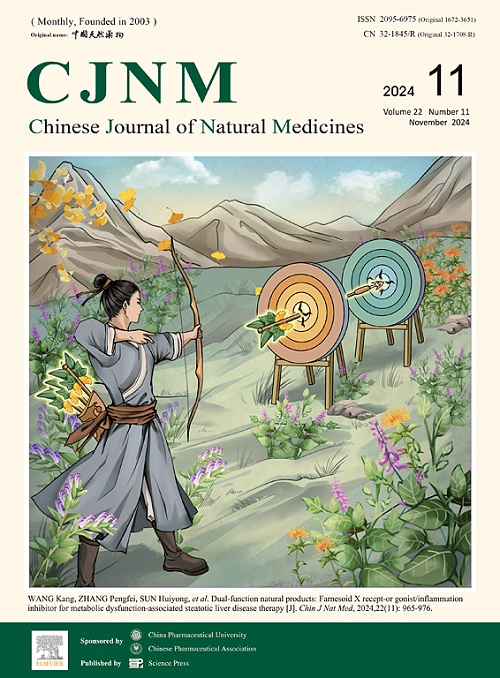Deciphering the therapeutic potential and mechanisms of Artemisia argyit essential oil on flagellum-mediated Salmonella infections
IF 4.9
2区 医学
Q1 INTEGRATIVE & COMPLEMENTARY MEDICINE
引用次数: 0
Abstract
Salmonellosis represents a global epidemic, and the emergence of extensively drug-resistant (XDR) Salmonella and its sustained transmission worldwide constitutes a significant public health concern. Flagellum-mediated motility serves as a crucial virulence trait of Salmonella that guides the pathogen toward the epithelial surface, enhancing gut colonization. Artemisia argyit essential oil, a traditional herb extract, demonstrates efficacy in treating inflammation-related symptoms and diseases; however, its effects on flagellum assembly and expression mechanisms in anti-Salmonella activity remain inadequately explored. This study aimed to elucidate the mechanism by which Artemisia argyit essential oil addresses Salmonella infections. Network pharmacological analysis revealed that Traditional Chinese Medicine (TCM) Artemisia argyit exhibited anti-Salmonella infection potential and inhibited flagellum-dependent motility. The application of Artemisia argyit essential oil induced notable motility defects through the downregulation of flagellar and fimbriae expression. Moreover, it significantly reduced Salmonella-infected cell damage by interfering with flagellum-mediated Salmonella colonization. In vivo studies demonstrated that Artemisia argyit essential oil administration effectively alleviated Salmonella infection symptoms by reducing bacterial loads, inhibiting interleukin-1 beta (IL-1β), IL-6, and tumor necrosis factor-alpha (TNF-α) production, and diminishing pathological injury. Gas chromatography-mass spectrometry (GC-MS) analysis identified forty-three compounds in Artemisia argyit essential oil, with their corresponding targets and active ingredients predicted. Investigation of an in vivo model of Salmonella infection using the active ingredient demonstrated that alpha-cedrene ameliorated Salmonella infection. These findings suggest the potential application of Artemisia argyit essential oil in controlling Salmonella, the predominant food-borne pathogen.
解读艾叶精油对鞭毛介导的沙门氏菌感染的治疗潜力和机制
沙门氏菌病是一种全球性流行病,广泛耐药沙门氏菌的出现及其在世界范围内的持续传播构成了一个重大的公共卫生问题。鞭毛介导的运动性是沙门氏菌的一个重要毒力特征,它引导病原体向上皮表面移动,增强肠道定植。艾叶精油是一种传统的草药提取物,对治疗炎症相关症状和疾病有疗效;然而,其对鞭毛组装的影响及其在抗沙门氏菌活性中的表达机制仍未得到充分探讨。本研究旨在阐明艾叶精油治疗沙门氏菌感染的作用机制。网络药理分析显示,中药艾叶具有抗沙门氏菌感染的潜力,并能抑制鞭毛依赖性运动。艾叶精油通过下调鞭毛和毛的表达诱导了明显的运动性缺陷。此外,它通过干扰鞭毛介导的沙门氏菌定植显著减少沙门氏菌感染的细胞损伤。体内研究表明,艾叶精油通过降低细菌负荷、抑制白细胞介素-1β (IL-1β)、IL-6和肿瘤坏死因子-α (TNF-α)的产生、减轻病理性损伤,有效缓解沙门氏菌感染症状。气相色谱-质谱联用(GC-MS)分析鉴定了艾叶精油中的43种化合物,并预测了它们对应的靶点和有效成分。利用活性成分对沙门氏菌感染的体内模型进行的研究表明,-柏木烯可改善沙门氏菌感染。这些发现提示艾叶精油在控制主要食源性病原菌沙门氏菌方面具有潜在的应用前景。
本文章由计算机程序翻译,如有差异,请以英文原文为准。
求助全文
约1分钟内获得全文
求助全文
来源期刊

Chinese Journal of Natural Medicines
INTEGRATIVE & COMPLEMENTARY MEDICINE-PHARMACOLOGY & PHARMACY
CiteScore
7.50
自引率
4.30%
发文量
2235
期刊介绍:
The Chinese Journal of Natural Medicines (CJNM), founded and sponsored in May 2003 by China Pharmaceutical University and the Chinese Pharmaceutical Association, is devoted to communication among pharmaceutical and medical scientists interested in the advancement of Traditional Chinese Medicines (TCM). CJNM publishes articles relating to a broad spectrum of bioactive natural products, leading compounds and medicines derived from Traditional Chinese Medicines (TCM).
Topics covered by the journal are: Resources of Traditional Chinese Medicines; Interaction and complexity of prescription; Natural Products Chemistry (including structure modification, semi-and total synthesis, bio-transformation); Pharmacology of natural products and prescription (including pharmacokinetics and toxicology); Pharmaceutics and Analytical Methods of natural products.
 求助内容:
求助内容: 应助结果提醒方式:
应助结果提醒方式:


